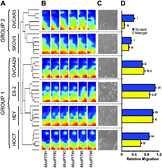Proteomic profiling has emerged as a useful tool for identifying tissue alterations in disease states including malignant transformation. The aim of this study was to reveal expression profiles associated with the highly motile/invasive ovarian cancer cell phenotype. Six ovarian cancer cell lines were subjected to proteomic characterization using multidimensional protein identification technology (MudPIT), and evaluated for their motile/invasive behavior, so that these parameters could be compared. Within whole cell extracts of the ovarian cancer cells, MudPIT identified proteins that mapped to 2245 unique genes. Western blot analysis for selected proteins confirmed the expression profiles revealed by MudPIT, demonstrating the fidelity of this high-throughput analysis. Unsupervised cluster analysis partitioned the cell lines in a manner that reflected their motile/invasive capacity. A comparison of protein expression profiles between cell lines of high (group 1) versus low (group 2) motile/invasive capacity revealed 300 proteins that were differentially expressed, of which 196 proteins were significantly upregulated in group 1. Protein network and KEGG pathway analysis indicated a functional interplay between proteins up-regulated in group 1 cells, with increased expression of several key members of the actin cytoskeleton, extracellular matrix (ECM) and focal adhesion pathways. These proteomic expression profiles can be utilized to distinguish highly motile, aggressive ovarian cancer cells from lesser invasive ones, and could prove to be essential in the development of more effective strategies that target pivotal cell signaling pathways used by cancer cells during local invasion and distant metastasis.

You have access to this article
 Please wait while we load your content...
Something went wrong. Try again?
Please wait while we load your content...
Something went wrong. Try again?


 Please wait while we load your content...
Please wait while we load your content...